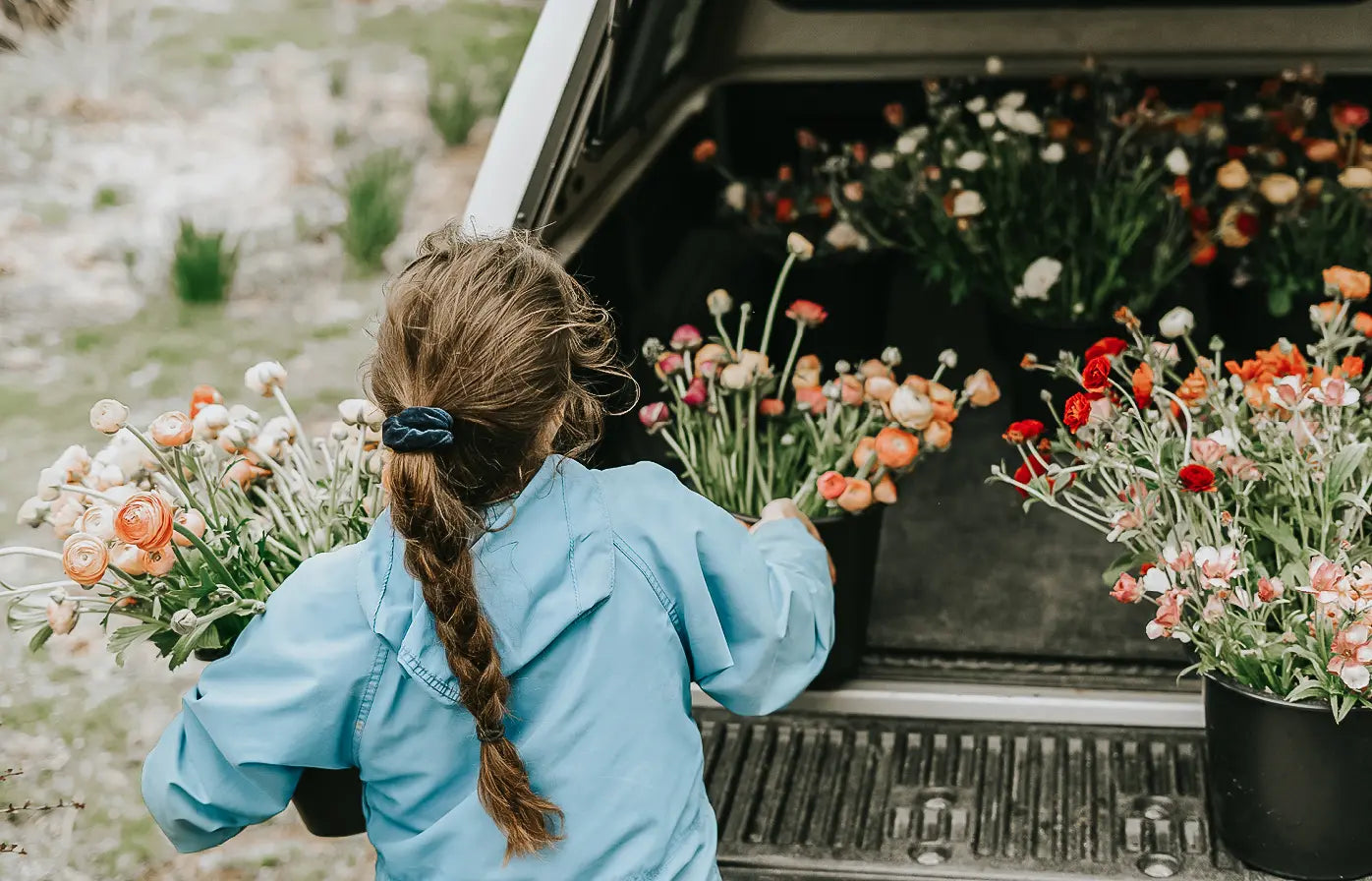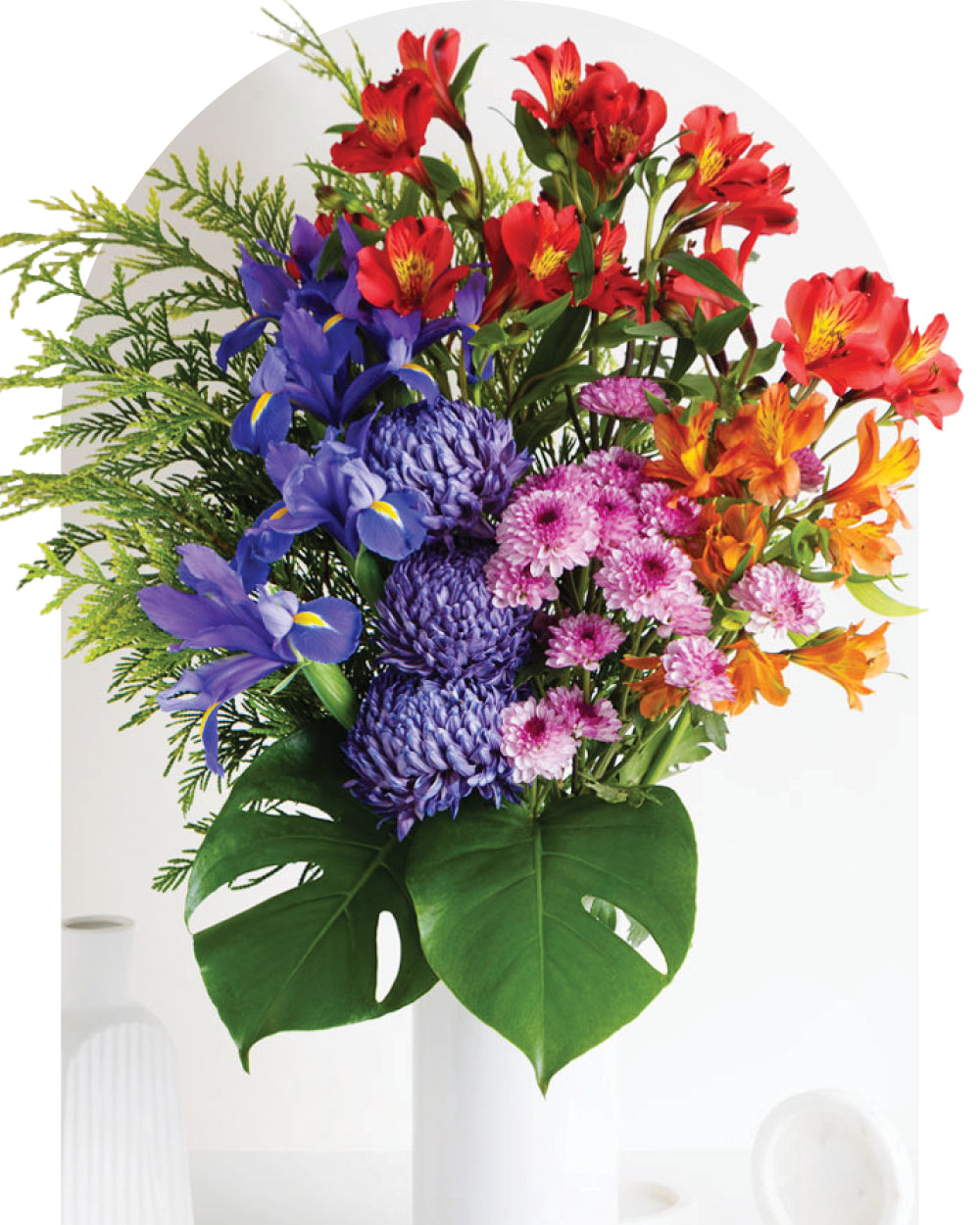We need to talk about sustainability in the flower industry! Fresh cut flowers are a much-loved luxury across the globe, and Australia makes no exception to this. In fact, between the years 2019 and 2020, the total value of cut flowers produced in Australia was worth $293 million!
Yet, there is another side to the story. Each year, Australians still spend around $70 million on imported flowers, while $8.4 million of Australia’s own production is exported to the likes of Japan and the Netherlands. This not only seems counterproductive but also has huge environmental consequences.
We take a closer look at the environmental impact of the lack of sustainability in the flower industry, and how we as florists can make changes to become more sustainable.

How does the lack of sustainability in the flower industry impact the environment?
CO2 emissions
While the Australian flower market is thriving, the world’s main source of cut fresh flowers comes from Ecuador, Kenya and Colombia, amounting to between 85 and 90% of production. Roses, carnations and chrysanthemums are the most imported flowers into Australia, often being flown up to six thousand miles in refrigerated vessels.
This global process has a catastrophic impact on the environment. According to the International Council on Clean Transportation, the US’ importation of Colombian flowers for Valentine’s day in 2018 cost the environment 360,000 metric tonnes of CO2 as TED points out. That’s almost the same amount as the CO2 emitted by 78,000 cars across a whole year.
And flower imports into Australia continue to grow. Sharon Holborn, executive officer of the industry body ‘Flowers Australia’ estimates that it has increased 20 fold over the last 10 years.
But why? Surprisingly, imported flowers are often cheaper to purchase than Australian grown varieties, despite transportation costs, primarily due to cheaper labour and fewer environmental protection laws than domestically. Varieties of flowers can also be produced year-round, as they can be sourced from different climates. They’re often seen as better quality, producing bigger flower heads than if they were grown in Australia.

Pesticide consumption
In order to extend the life of cut flowers, workers in the floral industry use chemical fertilisers, preservatives and insecticides. One of which is Methyl Bromide, a substance used to fumigate produce entering Australia to prevent the importation of diseases and pests that may harm our biosecurity. Yet Methyl Bromide is claimed to cause five times the amount of damage to the Ozone layer than Carbon Dioxide.
Not only are these chemicals harmful to the environment, but they also make their way back into our systems by seeping into the soil we grow our food in, the water we drink, and the air we breathe. Many of these substances are highly toxic to human beings, yet we continue to use these both on domestic flowers and those imported from abroad.
Unethical working conditions
Alongside crippling environmental issues, these practices have awful social consequences. Flower industry workers in importing countries have been known to suffer in poverty due to incredibly low wages and poor working conditions. On top of long working hours, the predominantly female workforces face trade-union repression and overcrowded housing.
Those working in the industry both abroad and domestically also face a higher risk of consumption of pesticides through much more concentrated exposure, thereby risking ill-health. Studies have shown that working conditions have been so severe in the rose industry that workers have experienced muscular tremors and twitching, blurred vision and abdominal pain.

How can a florist be sustainable?
With this environmental and social damage in mind, adopting more sustainable strategies in the flower industry has never been more important. We’ve put together some simple ways that you can become more sustainable in your floristry offerings, as well as what to look out for as a consumer.
How can you source sustainable flowers?
1. Buy local
As a florist, you should really be asking yourself, where am I actually buying my flowers from? If you’re buying from a large city flower market, such as Sydney Flower Market, make sure that you know the actual origin of the flowers. Better yet, source local flower farmers and get your produce from them directly. Not only will you be protecting the environment, but you’ll also help to support your local community.
As the end consumer whether you’re after a bunch of fresh flowers from your local florist or like to order online and send flowers to Melbourne, Sydney, Brisbane or anywhere else in Australia, make sure your trusted florist sources their blooms locally, too.

2. Opt for seasonal blooms
If you’re buying from local community farmers, you should only be sourcing seasonal flowers from your region of the country. If local produce isn’t available to you, the next best thing is to ensure that you’re buying other domestic, seasonal flowers. While this still risks higher CO2 emission than local purchase through greater transportation across our vast country, it’s certainly better for the environment than importing flowers from far and wide.
Buying seasonally reduces the need for heated domestic greenhouses which are a huge contributor to CO2 pollution. Rather than emulating the equatorial sun needed for certain flower varieties, opt fort hose that are available in Australia naturally. There are a huge number of exciting and stunning options at your disposal, and may even diversify your floral designs!
3. Purchase organic and Fairtrade
Ask yourself, who benefits from the purchase of these flowers? Aim to only buy from ethical producers. Ensure the welfare of flower industry workers and lower the environmental impact of cut flowers by buying from Fairtrade certified suppliers, or those that display other ethical accreditations such as the Rainforest Alliance. This way, you know that your flowers have been grown with the wellbeing of workers in mind and against strict environmental standards.
4. Reduce plastic consumption
As well as grand industry decisions, you can also make changes on a smaller scale that have a big impact; like reducing your plastic consumption. Rather than using cellophane, plastic vases and buckets, and decorative add-ons, try displaying your flowers in more sustainable materials, or use recycled or second-hand alternatives.
Floral foam should also be banned from your florists. Traditional foam is a single-use plastic, which is non-biodegradable, and breaks down into microplastics which are both water and air pollutants. It also contains substances that are toxic to humans such as barium sulphates and even formaldehyde: chemicals that should be nowhere near you or your staff. Try using chicken wire, straw, wood wool or moss to create displays instead.

5. Be responsible about waste
Waste is inevitable, no matter the industry. But we can try to be more responsible about our waste, and try to reduce it as much as possible. Alongside recycling any materials used for displays, or in the shop itself, you could also look at reusing your leftover flowers. Donate them to your local hospital to bring a smile to someone’s face, or you could even repurpose them by drying them out and reselling them.
Any leftover plant matter shouldn’t end up in your general waste. Composting is a great solution for your leftovers and even helps to complete the growth cycle by adding nutrients back into the soil that our flowers grow in.
6. Add houseplants to your product offering
Why not add a new offering to your shop? Houseplants are a great, sustainable alternative to cut flowers, offering customers a product with more longevity. You may even open yourself up to a new client base!

What are eco-friendly flowers?
If you’re looking to find the most eco-friendly flowers, there are a few extra things you can look out for:
- Aim for sources with low storage time for their flowers, and that have the lowest possible travel time. This way you’ll be lowering your CO2 emissions through refrigeration and delivery.
- Only order as much as you need! There is so much waste in the flower industry, with a large volume of flowers cut and not sold. Be sure that you’re only cutting the stems of flowers that will end up in a vase in someone’s home.
- Opt for flowers that haven’t been treated with chemical pesticides. Biological sprays, biostimulants or natural sources of pollination such as bumblebees are better for the environment and are less likely to cause you, and others, harm. Some farmers are actually using an organic method referred to as ‘insects against insects’, whereby natural enemies eliminate pests and diseases from flowers.
Shop sustainably
Hopefully, this has armed you with actionable tips to help you play your part in making the flower industry a more sustainable place. Find out how Fig & Bloom are continually striving to become more sustainable, or get your hands on a sustainable bouquet for yourself or a friend now.










